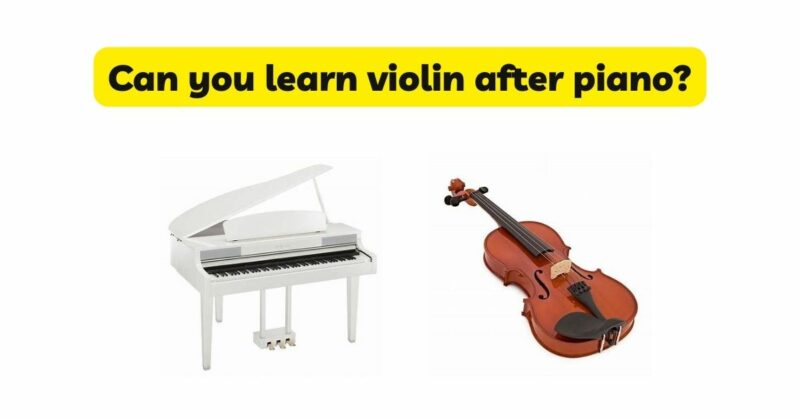The journey of learning a musical instrument is a rewarding and transformative experience. For those who have already mastered the piano, the desire to expand their musical repertoire by learning another instrument, such as the violin, is common. In this article, we will delve into the possibilities and considerations of learning the violin after acquiring piano skills. By examining the similarities, transferable skills, challenges, and advantages, we aim to provide insights into the feasibility and potential benefits of embarking on a violin learning journey after piano.
- Transferable Skills: One of the key advantages of learning the violin after the piano is the transferable skills acquired from piano playing. Piano players already possess fundamental musical knowledge, such as reading sheet music, understanding rhythms, and interpreting musical notation. These skills greatly ease the transition to the violin, as the basics of music theory and notation remain consistent across instruments. Additionally, finger dexterity, hand-eye coordination, and independence developed through piano practice can be advantageous when transitioning to the violin, as these skills are crucial for precise finger placements and bowing technique.
- Musical Understanding: Musical understanding gained from playing the piano is highly transferable to the violin. Piano players already possess a solid foundation in concepts such as dynamics, phrasing, and musical expression. This understanding allows for a smoother transition to the violin, as the principles of musicality remain consistent. The ability to shape phrases, interpret musical nuances, and convey emotions through music acquired from piano playing can enhance one’s violin playing. Additionally, piano players have developed a sense of timing and rhythmic precision, which can be applied to their violin performance.
- Ear Training and Intonation: Piano players often have a well-trained ear due to their exposure to different pitches, intervals, and harmonies. This ear training carries over to the violin, aiding in the development of accurate intonation. Piano players already possess an understanding of pitch relationships, which facilitates reproducing correct pitches on the violin. The ability to discern and reproduce accurate pitches enhances intonation and contributes to a more refined and expressive sound on the violin. With some adjustments and focused practice, piano players can apply their existing ear training skills to the specific intonation requirements of the violin.
- Technical Adaptations: While piano and violin are distinct instruments, there are certain technical adaptations that piano players must make when learning the violin. The physical aspects, such as holding the violin, positioning the bow, and developing proper bowing technique, require adjustment and practice. Piano players may initially find it challenging to transition from the familiar keyboard to the fingerboard of the violin. However, with guidance from a qualified violin teacher and dedicated practice, these technical adaptations can be mastered. The advantage of prior piano skills lies in the foundation of music theory, reading sheet music, and general musicianship, which accelerates the learning process on the violin.
- Practice and Dedication: As with any new instrument, learning the violin after the piano requires practice and dedication. While prior piano knowledge provides advantages, it is important to approach the violin as a distinct instrument and commit to building the necessary skills. Regular and focused practice is essential to develop muscle memory, finger coordination, bowing technique, and intonation accuracy. It is important to remain patient and embrace the learning process, as the transition from piano to violin may require adjustments and time to develop new skills specific to the violin.
- Seeking Guidance: To ensure a smooth transition and maximize learning potential, seeking guidance from a qualified violin teacher is highly recommended. A skilled instructor can provide guidance on proper technique, bowing, finger placement, and address specific challenges faced by piano players transitioning to the violin. They can also help adapt existing musical knowledge and skills to the unique requirements of the violin. Regular lessons and feedback from a teacher provide valuable guidance and support throughout the learning journey.
- Personal Motivation and Enjoyment: Ultimately, the decision to learn the violin after the piano should be driven by personal motivation and enjoyment. Consider your passion for the violin, the desire to explore new musical horizons, and the enjoyment you derive from the instrument. Learning a new instrument requires commitment, time, and effort, so it is essential to choose an instrument that resonates with your musical aspirations and brings you joy.
Conclusion: Learning the violin after acquiring piano skills is indeed a viable and rewarding endeavor. The transferable skills, musical understanding, and foundation in music theory gained from piano playing provide a strong foundation for violin learning. While there are technical adaptations and challenges to overcome, with dedication, practice, and guidance from a qualified teacher, piano players can successfully transition to the violin. The key is to approach the violin as a new instrument, with an open mind and a willingness to learn and adapt. Remember that the joy of music-making and the personal fulfillment derived from mastering a new instrument are the ultimate rewards. Embrace the journey, explore the unique qualities of the violin, and enjoy the transformative experience of expanding your musical horizons.


